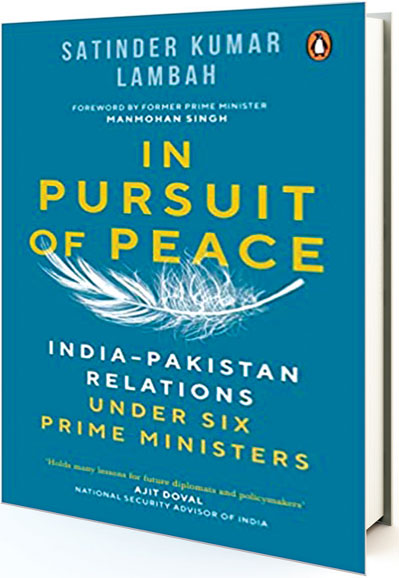Ambassador S.K. Lambah’s book would be useful for all future interlocutors whenever India-Pakistan decide to resume the dialogue
Pravin Sawhney
 Relations between India and Pakistan have been on a roller coaster ride with wars and hopes of peace. This has created scores of specialists with umpteen books entering the market each year. Ambassador S.K. Lambah’s book In Pursuit of Peace on these bedevilled relations stands apart. Having spent most of his foreign service career associated with Pakistan and having sought ways for peace under six Prime Ministers, Lambah’s observations are worth cogitation. Moreover, having been the Indian interlocutor in the back-channel talks with Pakistan from 2005 to 2014, Lambah provides exceptional insights on Pakistani mindset and perhaps some dots for the way forward.
Relations between India and Pakistan have been on a roller coaster ride with wars and hopes of peace. This has created scores of specialists with umpteen books entering the market each year. Ambassador S.K. Lambah’s book In Pursuit of Peace on these bedevilled relations stands apart. Having spent most of his foreign service career associated with Pakistan and having sought ways for peace under six Prime Ministers, Lambah’s observations are worth cogitation. Moreover, having been the Indian interlocutor in the back-channel talks with Pakistan from 2005 to 2014, Lambah provides exceptional insights on Pakistani mindset and perhaps some dots for the way forward.
I found Lambah’s suggestion for India to interact with the Pakistan army interesting and useful. He writes, ‘India finds itself in an awkward position because it has not yet grasped the art of fully tapping the army channel, and to that extent, is at a disadvantage.’ Why the Pakistan army? ‘The (Pakistan) army’s march to power came to be formalised in 1954 after Pakistan became an ally of the United States. It was from this point onwards that the role of the Pakistan Army as a stakeholder in the governance of the country was firmly established and acknowledged,’ he writes.
Since the writer was a diplomat, he failed to appreciate that it was the creation of the ceasefire line in Jammu and Kashmir on 1 January 1949, which formalised the Pakistan Army as the key stakeholder in Pakistan. The Pakistan Army’s importance in that country became coterminous with the existence of the military line with India. Since Jinnah wanted Kashmir to be a part of Pakistan, the Pakistan Army became the custodian of Pakistan’s India policy with Kashmir as the core issue. Given this, it was natural for foreign powers to interact directly with the Pakistan Army which, in turn, entered military partnerships to support its Kashmir policy. Moreover, India’s mindless nuclear tests elevated Pakistan Army’s stature since it was the army chief, General Jehangir Karamat (Retd), and not Prime Minister Nawaz Sharif, who, disregarding the US’s immense pressure, took the call to conduct tests of its own for strategic parity with India. Rawalpindi’s role in Pakistan’s foreign policy was no longer confined to India. For example, China, on General Pervez Musharraf’s (retd) urging decided to make the Gwadar deep-sea port as the southern-most end of the China Pakistan Economic Corridor.
Regarding the way forward, Lambah writes ‘At the outset, it needs to be recognised that Pakistan continues to be vague about its expectations on the Kashmir issue.’ I would argue that the Pakistan Army is not ‘vague” but is constantly adjusting its core concern of Kashmir to geopolitical vicissitudes; Pakistan, after all, is an important geopolitical pivot for geostrategic powers like China and the US. Consider this, after India revoked Article 370 in Jammu and Kashmir, Pakistan Army chief General Javed Qamar Bajwa (Retd) visited China for consultations. He was personally advised by Chinese President Xi Jinping to keep the Kashmir issue at an appropriate place and focus on economic prosperity for now.
This resulted in twin action by the Pakistan Army. One, it joined hands with Islamabad to release Pakistan’s first national security policy in April 2022 with connectivity and human centric approach for prosperity. And two, I was told by senior Pakistan Army officers in April 2022 in Islamabad that wars between India and Pakistan had only resulted in misery. It was now time for both sides to talk peace where the four-point Musharraf formula could be a good starting point. Lambah confirms in his book that back-channel talks under the Manmohan Singh-Musharraf regimes were comprehensive with high hopes of success.
A digression here is important. Lambah writes that “a disavowal of Pakistan of the use of terrorism as a state policy allowing the use of its territory by non-state actors” was an essential prerequisite for success of the talks. Pakistan’s proxy war since 1990 in Jammu and Kashmir was better handled by the Indian Army building credible counter offensive capabilities which would have to compel the Pakistan Army to review its strategy. This should not have been a condition for negotiations.
Coming back to the main narrative, Pakistan’s Kashmir policy will continue to change with changes in global geopolitics since South Asia has become an epicentre of great power politics, the other epicentre being the ASEAN in the Asia Pacific region. China not only occupied territory of undivided Kashmir, it also exercises influence through its Belt and Road Initiative, which barring India and Bhutan, has been endorsed by all South Asian nations. This is the reason why Xi advised Prime Minister Narendra Modi for regional peace (peace between India, Pakistan and China) at the second informal summit in Mahabalipuram (Chennai) in October 2019.
There is no doubt that the time for peace talks between India and Pakistan is not right at the moment. When they do happen, Lambah’s book would be useful for interlocutors on both sides.
IN PURSUIT OF PEACE: INDIA-PAKISTAN
RELATIONS UNDER PRIME MINISTERS
Satinder Kumar Lambah
Penguin, Pg 372, Rs 799

